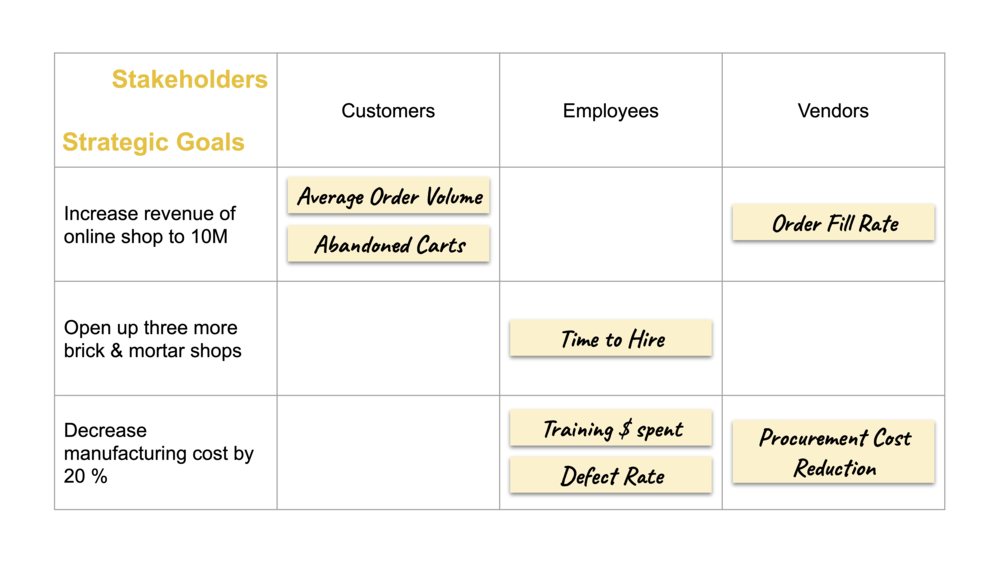
To be successful you got to have two things: Strategic goals and transparency to know whether you are getting there or not. Two powerful tools to support you in this are OKR and KPI.
As we sometimes see confusion with our clients about what is what, we labelled this post OKR vs KPI. But as we will see, OKR and KPI work together quite wonderfully. So first, let’s start with a definition.
OKR vs KPI – Definition
OKR MEANING
Objectives and Key Results (OKR) are a management tool for strategy execution. It helps you set quarterly goals and focus your work on strategically important topics.
It combines the larger vision — your strategic goals — with the operations of your business. In this, OKRs are similar to other goal-setting frameworks like Management By Objectives (MBO).
You break down your strategic goals into objectives and the key results you need to achieve in order to reach those objectives. It can be used by an individual or – much more powerfully – by your whole organization.
If used company-wide, it is a great tool to create strategic alignment between teams. And, there is a time component to it: OKRs are ideally set and reviewed in a fixed interval, we recommend quarterly.
KPI MEANING
KPI stands for Key Performance Indicator. They are – usually numeric – metrics that you define for your business. They measure the performance in areas that critical for your business’ success. A great set of KPIs will give you transparency over your company’s health, performance, and future success. And as Peter Drucker once said: What gets measured gets managed.
OKR vs KPI – How are they connected
Let’s use an analogy here from one of the first people to advocate the use of the OKR methodology, former Intel CEO Andy Grove. In his highly recommendable book High Output Management, he describes the concept of OKR as follows: Think about Objectives as the goal you want to reach. Let’s say you want to be at the airport at 3 pm; this could be your objective. The related Key Results of this objective could, for example, be all the places you pass on your way to the airport:
- Objective: Be at the airport at 3 pm
- Key Result 1: Pass Eglington Ave at 2:30
- Key Result 2: Pass Lawrence Road 2:45
- Key Result 3: Park Car at 2:55

The key results give you clarity over what you have to accomplish to reach your goal. To phrase it differently, the objectives are your destination, the key results let you know if you are getting there.
NOW, HOW DO KPIS COME INTO PLAY?
Think about KPIs as everything you can measure that will determine whether your output or your performance is great or not. In our example above, a KPI could be your average speed in km/h. Or your fuel consumption in case you have a long trip and want to avoid fueling up.
- KPI 1: Average Speed
- KPI 2: Fuel Consumption
- KPI 3: Time in traffic
And now you probably already see the connection: KPIs can be a part of your OKR definition. This is what it could look like in our example:
- Objective: Be at the airport at 3 pm
- Key Result 1: Maintain a minimum average speed of 50 km/h
- Key Result 2: Pass Eglington Ave at 2:30
- Key Result 3: Spend less than 4 minutes in traffic to be able to park car at 2:55
The bold terms are our KPIs. They are used to specify our key results. It would also be possible that an objective includes a KPI, but it’s not as common as in key results due to their more operative nature.
So as you see, the KPI, in this case, is used to define a key result and to make it measurable.
How to establish the OKR Framework for your company
THE COMPONENTS
The Time Period is long enough to reach something meaningful, yet short enough to adjust your course to new learnings or changes in environment.
Objectives are the targets you set for your next quarter.
Key Results are defined per objective and measure progress on your way to reaching the objectives.
THE PROCESS
The process of defining OKRs for your company requires that you know your strategic goals.
Next up, you define the three company objectives that you want to achieve in the next three months to arrive at your strategic goal.
Please resist the temptation to define more than three, because it will dilute your focus. Here is a strategy and OKR example for a small tax accountant business.
Strategic goal: Become the #1 tax accountant for restaurants and hospitality businesses in West Toronto.

Now, the objectives you derive for the next quarter are 100% depending on your strategy.
- Objective 1: Gain influence in social media and the local community
- Objective 2: Increase retention of existing hospitality clients
- Objective 3: Acquire ten new clients from the West Toronto hospitality industry
What’s still missing for this OKR example are the key results. They serve to operationalize the objectives, so you know if you arrive there throughout the quarter.
Many companies tend to define too many too detailed Key Results (to compensate for the limitation to three objectives), but again: This is not what OKRs are about.
You want to define a maximum of three to five key results per objective.
- Objective 1: Gain influence in social media and the local community
- Key Result 1: Increase followers on Instagram to 500 by posting relevant content daily
- Key Result 2: Attend at least three networking events to connect with local restaurant and hospitality business owners
- Key Result 3: Host 3 info sessions “Tax in Hospitality” for local business owners
- Objective 2: Increase retention of existing hospitality clients
- Key Result 1: Monthly check-in with all current hospitality clients to ensure customer satisfaction
- Key Result 2: Make sure the net promoter score for existing customers is above 80%.
- Objective 3: Acquire ten new clients from the West Toronto hospitality industry
- Key Result 1: Launch referral program where existing clients get 10% rebate for the next 6 months when they refer a new client
- Key Result 2: Launch offer campaign for new clients and leave flyer in at least 150 restaurants
- Key Result 3: Launch Facebook Campaign to promote the offer.
Now those are your company OKRs. In the next step, you can have them broken down by your teams. We highly recommend doing this in a public all-hands meeting.
The very goal of OKRs next to giving direction is to create accountability. So the earlier you make that discussion public, the better.
DEFINE OKRS FOR YOUR TEAMS
In the quarterly OKR meeting, you can present your strategic goals and the OKR you define for the company. By the way: we suggest sharing it one or two days in advance or even better, including your team in creating them in the first place.
Next up, your team leads define their team level OKRs, maybe with the help of an OKR coach.
Often, but not always, the key results from your company level OKRs can become your team leads’ objectives. But always make sure that the team leads have the freedom to add their own objectives that align with the company mission.
Adding some bottom-up objectives to the top-down approach will increase ownership of this goal-setting tool and strengthen employee engagement.
Again: There is no hard 1-to-1 ratio here. OKRs are about giving guidance, not about being mathematically accurate.
Defining the teams’ key results will need some negotiation between you and the team leads. Based on your company culture, have this conversation publicly or privately.
Once the teams have defined their OKRs, they can break it down further, so each team member ends up with a personal set of OKRs.
It’s super powerful when every individual in your organization has a clear set of three strategically important objectives to work on that align with your company strategy!
FOLLOWING UP AND GRADING OKR
In the middle of the three months, check in with your team leads to see where they stand with the OKRs. That should give you enough time to counter-steer in case you need to adjust or remove roadblocks.
At the end of the three months, schedule the next OKR meeting. In this public meeting, you and the team leads will grade their OKRs. Grading means measuring success with each key result.
Assign a points value between 0.0 and 1.0 to each key result. The average of these points value can be considered the grading for the objective.

Everything below .4 can be considered a failure: For those key results, critically assess if you still want to be pursuing them in the next quarter, they need adjustment, or you just want to drop them.
You want to aim for an average score of .7. If your average is much higher, it just means that your objectives aren’t ambitious enough.
The whole grading exercise should take each person not more than 5 minutes. Again, it’s more about assigning a rough point value than about being scientific with numbers.
After you have graded the company and team’s OKRs and discussed the results, use the same meeting to derive the OKRs for the upcoming quarter. Repeat this process every quarter.
This 3-month rhythm provides enough time to actually achieve things but on the other hand is short enough to react to changes in the business, market or competition.
The use of OKR software is not necessary – you can use simple google sheets or other simple software to write down your OKRs. The only important thing is that they’re publicly available for everyone in the company.
How to define your company KPIs
Now we have talked a lot about strategic direction and OKRs. How do you define your KPIs based on this? Very generally put, you should have a KPI for all your key results that will tell you if you actually moved the needle or not.
Some key results will not need a KPI; others will have two or more. The message is: Consider KPIs metrics that show you your success in achieving OKRs and for your company as a whole.
And then, there are KPIs that have nothing to do with your OKRs, but you still measure them. Why is that? Because OKRs deliberately narrow down your focus for one quarter on very few strategic topics. But that doesn’t mean that other parts of the business are not relevant anymore.
Lastly, not all performance indicators are relevant enough to use them to manage your company. Focus on the ones that really drive success – the key performance indicators.
A good set of KPIs can be constant for many years, whereas OKRs will most likely change – a little or a lot – from quarter to quarter.
So, how do you define your KPI system?
STEP 1: ASK YOUR TEAM WHAT THEY USE TO MEASURE PERFORMANCE.
Your team will have implicit performance measures already in place, whether they track them or not: They will have a good feeling over what makes their performance good.
So the first step is asking them. E.g., the account management team will know that upselling existing clients is a good thing, even though they might not be measuring it. Collect all that implicit knowledge.

STEP 2: QUALITY CHECK KPIS
A really useful KPI system should follow some rules. Check the KPIs you have collected against these criteria.
THE 3MS
Ask yourself these questions:
- Is this KPI meaningful? Why is it important for my business?
- Can I measure it? It doesn’t make sense tracking something that you can´t measure. So check the data source early in the process.
- Is it manageable? Monitoring indicators you have no control over will only stress you out.
LEADING VS LAGGING
You want your metrics to be as early in the process as possible and that they are causing outcomes, not depending on inputs.
Two examples:
- Sales revenue will, in most cases, not be a good KPI; measuring new incoming orders or customer acquisition would be better as they predict the future revenue. Thus, they allow you to act earlier in the process.
- Customer Lifetime Value is a great metric but a bit lagging, as it is a product of the leading indicators of customer retention and revenue per customer/time period.
This way, your comprehensive set of KPIs will not only show you the overall health of the company as of now, but also allow a look into the future.
OUTPUT, NOT ACTIVITY
You want to measure output, not activity. After all, you want to achieve results and not just keep people busy.
STEP 3: SORT THE KPIS YOU COLLECTED INTO A MATRIX OF STRATEGIC GOALS AND STAKEHOLDERS.
This step ensures that you are measuring the things that are defining your business success and are relevant to your strategic goals.
Decide on your strategic goals for your company. What you measure highly depends on where you want to go.
If you want to increase sales by increasing your retention, you will measure different things than as if you wanted to laugh new products or enter new markets.
It makes sense to use your strategic goals to determine your KPIs, as they are much more stable than your quarterly OKRs.

Making sure all stakeholders are covered has proven valuable in designing a 360° KPI system that considers all parties relevant to your business.
It’s not necessary to have a KPI for every strategy/stakeholder combination; it would be sufficient to have at least one for every strategic goal and every stakeholder.
However, filling every combination will give you a super-comprehensive KPI system. Add KPIs as needed.
Also, make sure all teams have KPIs they can work with. If you can’t come up with KPIs for one of your teams, ask yourself why that is.
Also, take a look at industry standards. It might make sense to include some KPIs that are common in the industry to benchmark.
STEP 4: SET UP THE PROCESS OF KPI MEASUREMENT AND A KPI DASHBOARD
Define a person responsible for collecting and monitoring KPIs. Often, but not necessarily, this person is located in the controlling controlling department.
Define the data source, who collects it how often, and where and how the KPIs are calculated. Create a visual representation of the numbers, as visuals are so much more powerful than numbers alone. Such a KPI dashboard can be a powerful tool.

You also have to decide if you want to calculate the KPI manually or automatically. That depends on the frequency you want to look at them. Automated data retrieval and calculation has the benefit of having data available at no time and effort, any time.
If there’s somebody who is manually compiling data or at least documenting the KPI, let’s say for the weekly meeting, I’ve found that this is a super valuable exercise as people need to spend time looking at their performance.
“Sometimes, creating a report is more valuable than reading it.”
OKR vs KPI – Which system do you need
The answer is both.
OKRs will help you direct your employee performance towards your strategic goals. And they will help to not get overwhelmed by the never-ending stream of things you could be working on. The KPIs you measure can be used to define your key results.
A great, tailored KPI system will give you the insights to see if you are actually improving and to recognize changes in your business early! A change in a KPI (e.g. dropping retention rate) might be the trigger for one of next quarter’s KPIs.
So it’s not either-or, but simply two different but equally powerful tools for you to help scale your company!
What’s your experience with OKR vs. KPI? Let me know in the comments.
Happy Scaling!
Best
Benjamin